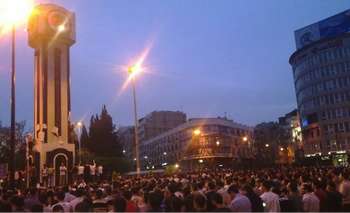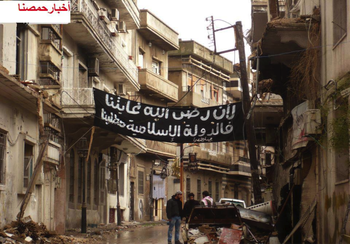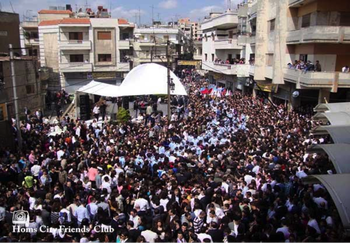It was Palm Sunday 2010 in the Christian quarter of Homs, Syria, where thousands of inhabitants gathered in the area square to celebrate the holy event.
People marched from their houses and churches toward the square. Parents were carrying their infants. Children, youth and young adults were wearing nice clothes and holding olive branches and candles. All were singing, “Hosanna in the highest.”
A year after, on Palm Sunday 2011, a different march with different people with different slogans took place in Homs.
Thousands of Muslim men marched toward the city square, passing by the Christian quarter.

Demonstrators in Homs city square on Palm Sunday 2011. —courtesy of Paul Seebeck
That day, Christians celebrated Palm Sunday fearfully. They stayed at home or inside their churches. That same night, sounds of fighting, shooting and screaming “Allah Akbar” filled the city of Homs, announcing the beginning of a new era. Since then, Homs was never the same.
What was supposed to be peaceful demonstrations turned out to be a cover for violence. Slogans of freedom, democracy and human rights were rapidly substituted with phrases of hatred, cursing and enmity accompanied with act of violence.
From the Palm Sunday on, violence, shooting and fighting happened every day in Homs. People from different sides or no side were shot and killed.
Opposition fighters continued their violent actions against the police and some civilians, believing that aggression, assassinations and crimes in Homs — including the Christian quarter — would lead to the collapse of the ruling regime in Damascus 165 kilometers south.
Days, weeks and months passed on while victims and destruction continued to increase.
In 2012, Homs could not have Palm Sunday of any kind. Rebels had occupied the old city of Homs, including the Christian quarter, evacuating the area of its inhabitants.

Photos in 2012 of the same square of former Palm Sunday 2010 at the Christian Quarter in Homs old city. The Jihadist banner reads "because we seek Allah's satisfaction we will make Islamic state." —courtesy of Paul Seebeck
On Sunday, Feb. 26, 2012, a major displacement of more than 60,000 civilians of Christian majority happened in Homs. People left their homes and could not come back again until today.
As consequence of the rebels’ invasion, civilians were killed, houses were stolen and churches were destroyed. Violence has only led to more violence, more victims and more destruction.
Armed opposition fighters led the primitive movement of reform, freedom and human rights into a hell. Arming the opposition fighters to fight the ruling regime has ended up supporting radical Islamism and terrorism.
Christians of Homs still hope to celebrate Palm Sunday in 2015.
We still hope to see people back to their homes and churches. We hope to see them marching in joy carrying the olive branches and singing “Hosanna in the highest.”
To hear that chant again from Homs, located 400 miles north of Jerusalem, where the Lord Jesus once marched toward the city of Peace; to hear that chant from Homs, located 100 miles north of Damascus, where Paul walked in the straight street, you need to take an action.
I invite you all today to send a message of peace to one or two influential friends. Please tell them that violence will only lead to violence. Arming fighters has only led to more tragedy.
Peace be with you and through you.
This story was furnished by Paul Seebeck, communications strategist, who with Rob Bullock of the Presbyterian Foundation spent a week in Lebanon listening to the stories of Syrian refugees of that country’s proxy war. Some of these Christians are still in their homes, but very afraid.

